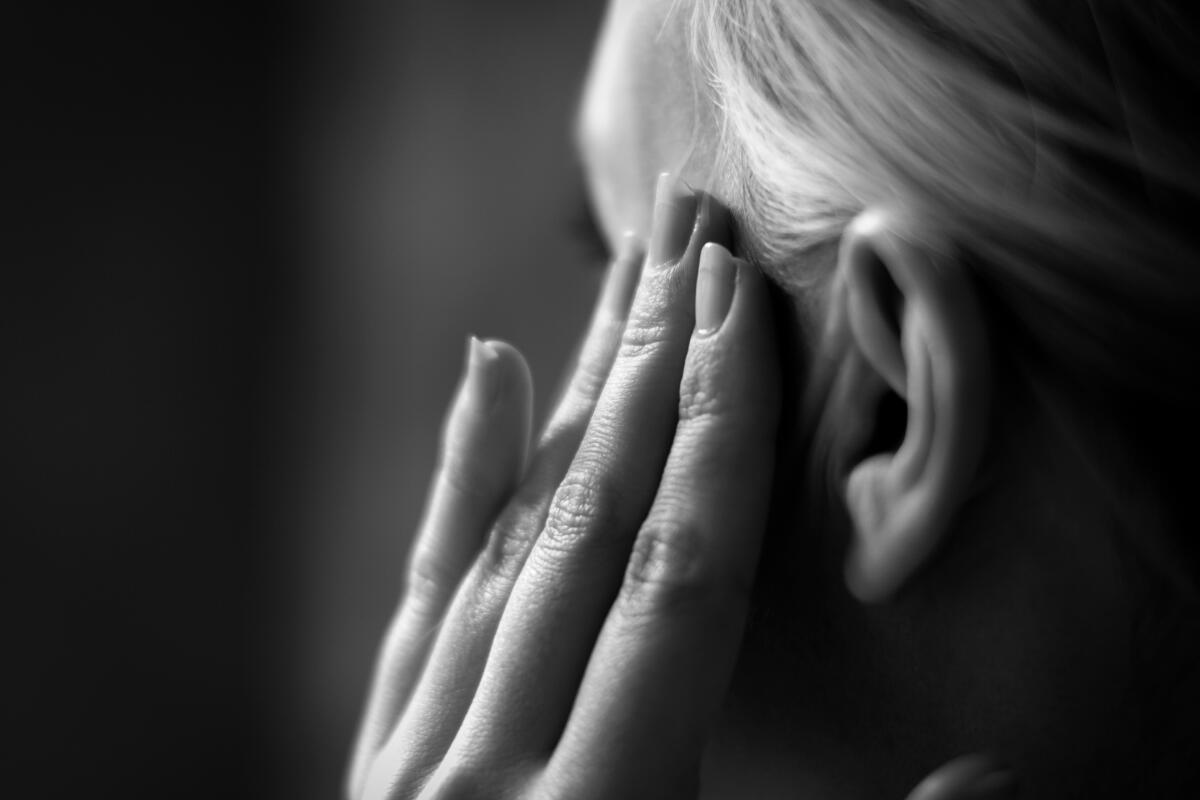Op-Ed: Is that pain you feel all in your head?

- Share via
When I prolapsed a disc in my spine in the middle of a bench press back in medical school, pain became a persistent presence in my life, and I feared that my injury would end my nascent career as a physician. I completely forgot what it was like to be pain-free. I often considered the only way to end my suffering would be by ending my life. Yet because I had no wounds or scars, friends and colleagues questioned whether my pain was all in my head.
That phrase felt like an erasure of my person, but I know now that there is more truth in it than any of my questioners could have imagined.
Over the next few years, I did prescribed physical therapy exercises, sometimes multiple times a day; consulted with a surgeon (who steered me away from an operation that might have made things worse); and started sleeping with three pillows to keep my spine aligned. Thanks to those interventions — and luck — my pain shrank from an occupying force to an intermittent intruder in my body.
Yet all of that progress began to erode as I worked on a book about the nature and history of pain. One day I couldn’t move my neck. Then it was my shoulder. Then it was my other shoulder. Parts of my body I barely knew existed haunted me with pain. I couldn’t hold a cup of coffee or slice a cucumber after the joints in my right hand swelled up. I developed shingles on my chest. My left inner thigh hurt so much I literally whimpered when I moved it.
As pain barged back into my life, I would often be up at night trying, and failing, to pinpoint a diagnosis that could explain what I felt. Devoid of another explanation, I began to wonder if the pain was all in my head.
Chronic pain affects 1 in 5 people around the world, and for many, their agony controls and constrains their lives. Being told that pain is a figment of an overactive imagination is too often a way to dismiss real suffering, but pain researchers know that most pain, and especially chronic pain, is a complex phenomenon that always involves the mind and the body. Acknowledging that connection and destigmatizing the phrase “all in the head” is crucial, not least because the mind represents the most promising therapy for chronic pain.
Our bodies are lined with nerves always on the lookout for heat, cold, chemical irritants and forceful pressure. Detection of these threats causes what’s called nociception, neural signals unconsciously transmitted to the brain, which in turn generates the conscious experience we refer to as pain. It is the brain that puts the hurt in pain.
Dying from heart disease correlates more closely with your ZIP Code and bank balance than with your gene pool.
One can even experience nociception without pain: Most soldiers who suffer gruesome wounds report no pain, perhaps because they are too overwhelmed by battle, or too distracted to transform nociception into pain. Enthusiasts of endurance sports, sexual masochism or certain religious rituals can experience ecstasy rather than pain from nociception.
So if one can experience nociception without hurting, is the opposite true as well? Could you hurt without any nociceptive trigger? Could my incessant thinking about pain, my intense attempts to remember my pain at its worst, and my many conversations with fellow sufferers of chronic pain during my research explain why pain was resurrected in my body?
Certainly the mere expectation of pain can cause us to hurt. This phenomenon is most clearly represented in the nocebo effect, the dark cousin of the placebo effect. It causes us to feel negative sensations just because we anticipate them. Nocebo pain is common in clinical trials when people fear that experimental drugs will cause them pain, though they are getting nothing more than a sugar pill.
Our brain’s ability to birth pain all on its own, however, also provides the basis for our most human quality — empathy. Simply witnessing another person’s suffering activates the parts in our brain responsible for generating pain within us.
The notion that pain can exist without incitement is widely accepted in scientific circles. Pain’s most widely accepted definition calls it “an unpleasant sensory and emotional experience associated with, or resembling that associated with, actual or potential tissue damage.” Vania Apkarian, a renowned pain researcher at Northwestern University, goes even further, telling me that pain is an emotion localized in the body. Apkarian’s research strongly suggests that unlike acute pain, chronic pain has more in common with emotion and memory than physical sensations.
Physicians’ values and norms save our lives and cost us dearly.
One reason patients might be rightly wary of accepting the multifaceted “in your head” nature of pain is because of the stigma that continues to be attached with disorders of the mind. Yet such reluctance means patients could be deprived of some of the most promising treatments for chronic pain. These include cognitive behavioral therapy, hypnosis, pain reprocessing and acceptance therapy.
“I am a counselor for people who are suffering. I help people come to terms with how they feel and gain a semblance of control,” Bob Jamison, a pain psychologist, told me. “If your pancreas stops working, you have to make huge changes — you have to start checking your blood sugar, you have to start taking insulin. Chronic pain is the same way.”
Although there is no silver bullet for chronic pain, interventions that focus on helping people live with what hurts them or changes how they feel about pain are a central feature of gold-standard, interdisciplinary pain treatment. Yet for patients to get access to this kind of care, the term “all in the head” needs to be reclaimed and redefined. Instead of using it to belittle or delegitimize, it should be used to empower.
As I learned through my own journey with pain, including its recurrence, the root of both our suffering and salvation is within us, even when we reach our breaking point.
Haider Warraich, a physician at Brigham and Women’s Hospital, Harvard Medical School and the VA Boston Healthcare System, is the author of the just published “The Song of Our Scars: The Untold Story of Pain.”
More to Read
A cure for the common opinion
Get thought-provoking perspectives with our weekly newsletter.
You may occasionally receive promotional content from the Los Angeles Times.










